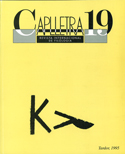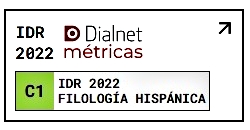Entonació i conversa: aproximació als mecanismes prosòdics demarcatius d'unitats sintàctiques en la parla col·loquial
DOI:
https://doi.org/10.7203/caplletra.19.7369Keywords:
fonologia, entoncació, conversa, prosòdia, sintaxi Abstract
Abstract
The purpose of this essay is basically informative; we are dealing with studies related to the prosody of spontaneous speech which are still not very well known in the world of Spanish linguistics (which includes Catalan linguistics). We offer a general state of affairs, and do not seek, therefore, to present the conclusions or results of any individual empirical study, but rather to point out some of the latest channels of investigation.
The criteria adopted in the exposition of authors and schools are chronological and epistemological, both of which overlap. Knowledge regarding the demarcative function of intonation has been perfected comparably to the development of linguistics; from the study of ideal and isolated units of sentence we go over to consider total units formed by elements of an inferior category (Sentence Functional Perspective), which leads us to the need to justify how enunciative contents are presented (School of Prague, English Systematics ...). Once we have transcended the frame of sentences and of the analysis of macro-units in oral language we are taken from the study of the demarcative mission of intonation inside a contribution, to denote the boundaries between contributions (turns).
368
We therefore find ourselves before discursive or interactive and conversational approaches (Schools of Edimburgh and Birmingham; I. Lehiste ...). Finally, it seems correct to defend the demarcative viewpoint in the hierarchical function of intonation, establishing boundaries between units in their different levels of linguistic expression (Phonological Hierarchy of Linguistic Units, Treach 1974).
 Downloads
Downloads
Downloads
Published
How to Cite
-
Abstract455
-
PDF (Català)200
Issue
Section
License
Authors submitting work to Caplletra for publication must be the legitimate holder of the usage rights. Legitimacy for the purposes of publishing the work must also include images, tables, diagrams and any other materials that may complement the text, whether they are the author of such material or not.
Copyright: on publishing their work in the journal, the author grants Caplletra. Revista Internacional de Filologia usage rights (reproduction, distribution and public communication) for both the paper printed version and for the electronic version.
All work published in Caplletra is covered by the Creative Commons license type Attribution-NonCommercial-NoDerivatives 4.0 (CC BY-NC-ND 4.0).
RESPONSABILITY
Caplletra. Revista Internacional de Filologia does not necessarily identify with the points of view expressed in the papers it publishes.
Caplletra. Revista Internacional de Filologia accepts no responsibility whatsoever for any eventual infringement of intellectual property rights on the part of authors.






